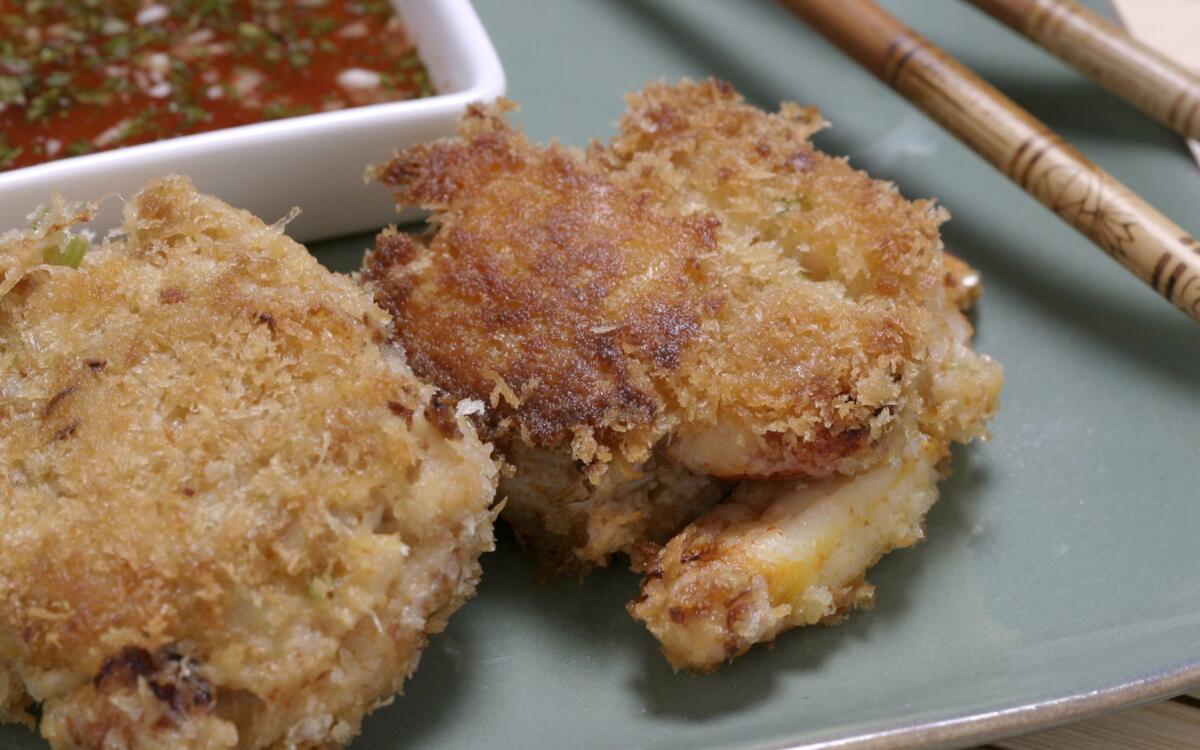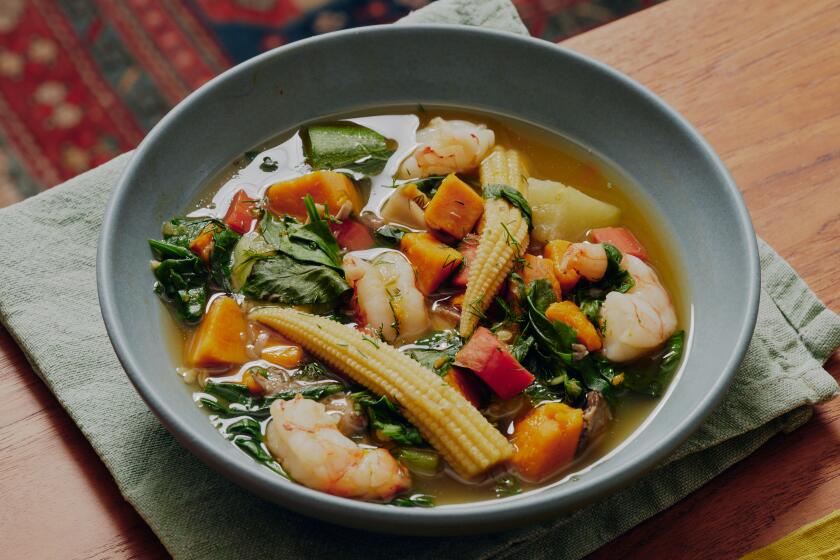Wild Ginger's Dungeness crab cakes with lime dipping sauce

Seattle chef Tom Douglas likes to recount how he moved to that hotbed of Dungeness crab in 1977 and could not find a crab cake to save his mid-Atlantic soul. He put one on his first menu, adapting a Delaware recipe to the Pacific crab, and restaurant reviewers could write about nothing else. Now he is so famous for his crab cakes that he has written an entire book about them.
“I Love Crab Cakes!” is just the latest manifestation of what Douglas sees as a national obsession. Crab cakes are on menus from coast to coast now, and no longer do you have to reflexively ask if they are made from real crab and not that crime against nature, surimi. A delicacy that once required a trip to the Chesapeake has become a mainstay even in Hollywood, where the Hungry Cat has had critics and diners swooning over crab cakes made from a second-generation recipe by another chef with roots back East (in Baltimore).
As Douglas notes in his new book, written with Shelley Lance: “When I sent out a request to my chef buddies around the country for either a regional favorite or their personal favorite crab cake recipe, no one responded with a ‘Sorry, I don’t make crab cakes.’ ” Instead, he garnered personal bests from Jacques Pepin in Connecticut, Emeril Lagasse in New Orleans and Nancy Silverton in Los Angeles, among others.
Anyone already inducted into the crab cake cult needs no persuading of its irresistible power. Made right -- fat with crab and light on filler -- crab cakes are about as good as American cooking ever gets. If they’re on the menu, you have to order them. And chefs know it.
What’s surprising is the reason Douglas offers to explain why crab cakes have become a national phenomenon.
“It’s really come on in the last 15 years or so,” he said. “The technology for canning crab, without freezing it, has changed the whole crab distribution system. Phillips canned pasteurized crabmeat is in every Costco in every city. Good crabmeat is just more widely available.”
He said he was only surprised that no one had already done a cookbook to capitalize on the trend. Using Jasper White’s “50 Chowders” book as a model, Douglas and his coauthor came up with a very small but extremely thorough guide to the most seductive of American foods. Its most important point may be that crab from anywhere will work: Blue crab and Dungeness are interchangeable when it comes to cake-making. Both have sweet flavor and superb texture, which are vital. A crab cake should not be soft or gummy or smooth. Chunky is a good thing.
In an ideal world, the signs along every highway boasting of “billions and billions sold” would be tracking crab cakes. But two things have kept crab cakes from becoming burgers of the sea. The main ingredient is nowhere near as cheap as ground beef. And, far more important, the very best crab cakes are always cooked in small batches, not in some industrial kitchen where corners get cut and hefty profits made. Douglas dedicates his book to his mother, “who, when asked where she goes for her favorite crab cakes, responded, ‘Right in my kitchen, of course.’ ”
David Lentz, the chef/owner of the Hungry Cat, said he never orders them in restaurants. “They’re not done correctly,” he said. “To me they’re really simple. People try to do too much to them.” Even though he has switched to Dungeness crab from the pricey blue crab he grew up with, he still believes “crab is delicate, and I think the flavor should pretty much stand alone.”
I order crab cakes wherever I see them, but Lentz and Douglas’ mother know best. Which is why I’ve learned how to make them better at home than I could buy. For starters, if you mix crabmeat with as little binder as possible, you get straight-ahead crab flavor. But you also get crabmeat that falls apart in your frying pan. The trick is to shape the flavored crab into cakes and then let them chill until they firm up enough to hang together as they fry. Half an hour makes all the difference between bread patties and sizzling crab cakes.
What goes into an incredible crab cake is incredibly simple: crabmeat, eggs as a binder, some kind of onion (green, white, shallot), herbs (parsley, cilantro, chives, basil), salt and pepper. Old Bay Seasoning is the standard-issue Chesapeake Bay spice blend, but you can also add dry mustard, Worcestershire sauce, Tabasco, herbes de Provence or any other splash of flavor. What you ultimately want, though, is just clean crab flavor, with a bit of piquancy from the seasoning.
Mayonnaise is also usually an essential ingredient, both to help the crabmeat cling together and to keep it moist. You could make your own, but Best Foods works fine.
Probably the most disputatious additive to crab cakes is the filler, which can be anything from fine dry bread crumbs to crushed potato chips, with crumbled saltines and fresh shredded baguette in between. Something is needed to help hold the crab cakes together, but it should be added with a light hand. The emphasis should be on crab, not extender. For the same reason, I never add chopped celery or peppers to crab cakes. Vegetables belong on the side.
One of the fusion recipes Douglas collected is a lesson in technique, though. The crab cakes from Wild Ginger in Seattle include no mayonnaise and no bread crumbs and are highly seasoned with red curry paste, cilantro roots and fresh ginger. All of that is held together with only eggs. The mixture is extremely wet and looks hopeless until you shape it into patties and drop them into panko to coat, then let them chill. The result is pure crab flavor with excellent texture, airy but firm.
Although tartar sauce is the classic partner for crab cakes, Wild Ginger’s are meant to be dunked into a spicy blend of Asian fish sauce spiked with chile paste and perfumed with minced mint, basil and dill. It’s refreshing, but there is still much to be said for adding richness to richness with a creamy sauce.
The simplest sauce is just mayonnaise mixed with chipotle in adobo sauce, a little garlic and cilantro and a splash of lime juice -- the smoky chile amplifies the sweetness of the crabmeat. But other possibilities are limitless, starting with a variation on the classic French sauce gribiche that uses sour cream instead of olive oil to emulsify sieved hard-cooked eggs, capers, cornichons, shallots and mustard. Pureed piquillo or roasted red peppers can also be mixed with mayonnaise and seasoned with smoked paprika for a vibrant sauce. Avocado is always sublime with crab cakes, and the smoothest way to apply it is in combination with tomatillos and serrano chile, in a salsa inspired by one made by cookbook author and restaurateur Zarela Martinez.
Crab cakes can never be about skimping. A pound of crabmeat will serve no more than four for dinner (maybe eight at lunch). Two on a plate will make a meal, but a single crab cake can also be a starting point for something more. It can be tucked into a sandwich or, as Lentz has done at the Hungry Cat, combined with a poached egg, bacon and hollandaise for crab cake Benedict.
His regular crab cakes are off the menu now, during soft shell crab season. But they have been “super popular” and will be back in late summer. You can’t keep a good obsession down.
For the crab cakes, whisk the eggs lightly in a large mixing bowl. Add the curry paste and whisk until completely blended. Using a rubber spatula, mix in the green onions, shallots, cilantro and ginger. When everything is well combined, gently stir in the crabmeat and mix well.
Spread 1 1/2 cups panko in a wide shallow container. Divide the crab mixture into 8 mounds and gently squeeze out any excess liquid. Shape the crab mixture into patties, laying them in the panko. Sprinkle as much of the remaining panko as needed to cover the tops. Cover the crab cakes with plastic wrap and refrigerate for about 30 minutes (these do not sit well overnight).
For the dipping sauce, combine 2 tablespoons of water with the fish sauce, lime juice, sugar, sambal oelek, garlic, dill, mint and basil in a small bowl and mix well. Set aside.
Place 2 large nonstick or cast-iron skillets (or use one pan and cook in batches) over medium-high heat and pour in enough oil to coat the bottom of the pans by about one-eighth inch. When the oil is hot, shake the excess panko from the crab cakes, add 4 to each pan and reduce the heat to medium. Fry until the cakes are golden brown and heated through, turning once with a spatula to brown both sides, 3 to 5 minutes on a side. Reduce the heat as needed so they don’t brown too quickly.
Drain on paper towels and serve with the dipping sauce.
Get our Cooking newsletter.
Your roundup of inspiring recipes and kitchen tricks.
You may occasionally receive promotional content from the Los Angeles Times.















